
Mordhau
Encyclopedia

German school of swordsmanship
The German school of fencing is the historical system of combat taught in the Holy Roman Empire in the Late Medieval, Renaissance and Early Modern periods , as described in the Fechtbücher written at the time...
, is the term for the technique of holding the sword inverted, with both hands gripping the blade
Blade
A blade is that portion of a tool, weapon, or machine with a cutting edge and/or a pointed tip that is designed to cut and/or puncture, stab, slash, chop, slice, thrust, or scrape animate or inanimate surfaces or materials...
, and hitting the opponent with the pommel or crossguard
Crossguard
On a sword or some knives, the crossguard , also known as quillons, is a bar of metal at right angles to the blade, placed between the blade and the hilt. The crossguard stops the wielder from punching shields while swinging the weapon, thereby protecting the user's hand...
. This technique allows the swordsman to essentially use the sword as a mace or hammer
War hammer
A war hammer is a late medieval weapon of war intended for close combat action, the design of which resembles the hammer.The war hammer consists of a handle and a head...
. The Mordhau is mainly used in armoured
Plate armour
Plate armour is a historical type of personal armour made from iron or steel plates.While there are early predecessors such the Roman-era lorica segmentata, full plate armour developed in Europe during the Late Middle Ages, especially in the context of the Hundred Years' War, from the coat of...
combat, although it can be used to surprise an opponent in close quarters. This technique has also been called a "thunder stroke".

